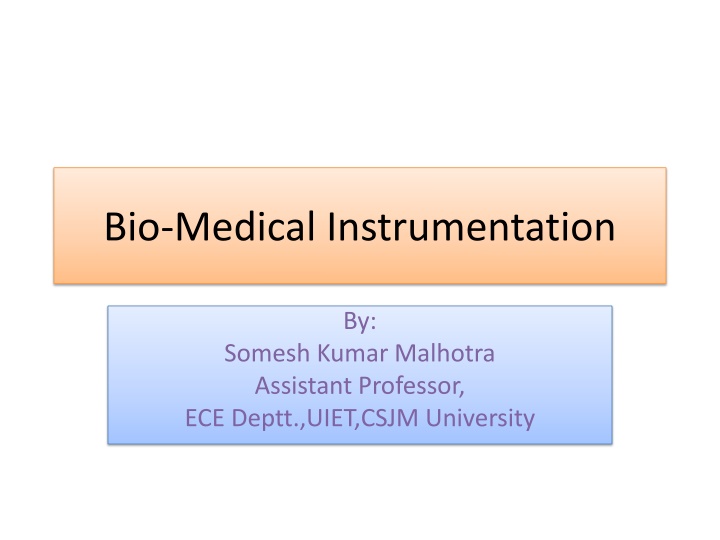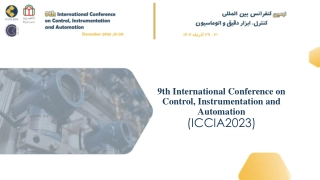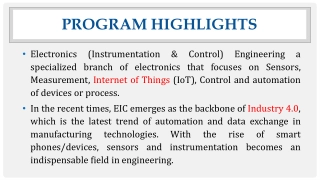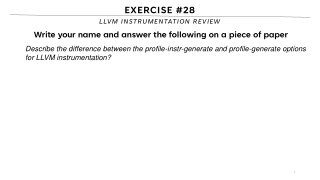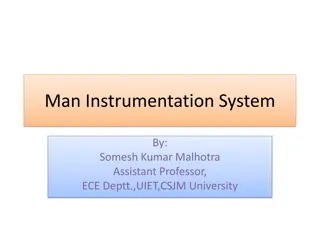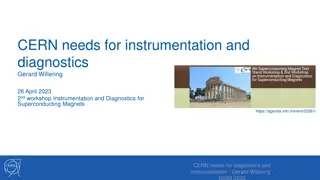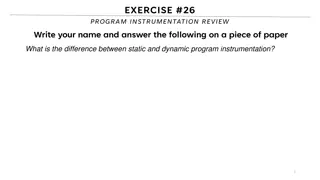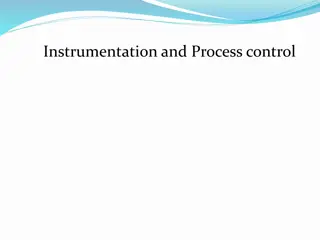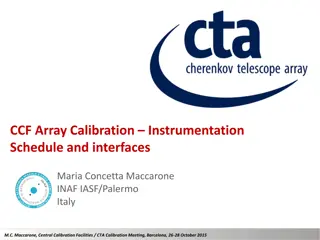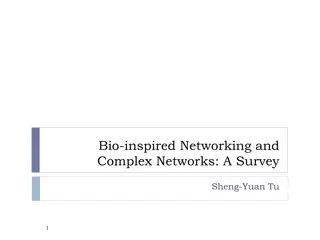Bio-Medical Instrumentation
Dive into the world of bio-medical instrumentation with insights from Somesh Kumar Malhotra, an Assistant Professor in the ECE Department at UIET, CSJM University. Explore the fundamentals, applications, and latest developments in this field, covering topics such as medical sensors, imaging technologies, signal processing, and more. Gain a comprehensive understanding of how bio-medical instrumentation plays a crucial role in modern healthcare and research, bridging the gap between engineering and medicine.
Uploaded on Feb 17, 2025 | 11 Views
Download Presentation

Please find below an Image/Link to download the presentation.
The content on the website is provided AS IS for your information and personal use only. It may not be sold, licensed, or shared on other websites without obtaining consent from the author.If you encounter any issues during the download, it is possible that the publisher has removed the file from their server.
You are allowed to download the files provided on this website for personal or commercial use, subject to the condition that they are used lawfully. All files are the property of their respective owners.
The content on the website is provided AS IS for your information and personal use only. It may not be sold, licensed, or shared on other websites without obtaining consent from the author.
E N D
Presentation Transcript
Bio-Medical Instrumentation By: Somesh Kumar Malhotra Assistant Professor, ECE Deptt.,UIET,CSJM University
Background The prefix bio, means something connected with life in biomedical engineering. Biophysics and biochemistry interdisciplines basic sciences have been applied to living things. Similarly, Bio-instrumentation means measurement of biological variables. The field of measurement is referred to as biometrics
Background Engineering Joint council committee on Engineering Interactions with Biology and Medicine recommended that bio-engineering be defined as application of the knowledge gained by engineering and biological sciences as both were more fully utilized for the benefit of a man. Biomedical engineer is a person working in research or development in the interface area of medicine and engineering, whereas physicians and patients is called a clinical engineer a cross fertilization of practioner working with
Background Association for the Advancement of Medical Instrumentation (AAMI) consists of both engineers and physicians. Most clinical engineers go into profession through the engineering degree route, but some may start out as physicists.
Background Some of the instruments like electrocardiograph were first used by the end of nineteenth century. But the progress was slow until the end of World War-II. After the war lot of electronic equipments such as amplifiers and recorders became available. Many technicians and engineers started to experiment with and modified existing equipment for medical use. The result of development did not yield good result due to the lack of understanding of physical parameters and communication problem with the medical professionals.
Background During 1951-60, many instrument manufacturers entered the field of medical instrumentation. But development was slow due to high costs of development. The hospital staffs was reluctant Many times, the medical staff was uncooperative. Help was provided by the US government, in particular by NASA. A large number of physiological parameters needed to be monitored for the astronauts. Hence, aerospace medicine programmes were expanded considerably, both within NASA facilities, and through grants to Universities and hospital to use new equipment. research units.
Background Some of the concepts and features of patient-monitoring systems presently used in hospitals all over the world is based on astronaut monitoring system. In short, the engineers and technicians started working with medical professional. The bio-medical engineering involves communication between the engineer and the medical professional. The language of the physician is quite different from those of the engineer. The physician must understand enough engineering terminology for him to discuss problems with the engineer. The burden of bridging the communication gap falls on the engineer. The result is that the engineer, must learn the doctor's language, as well as some anatomy and physiology, in order that the two disciplines can work effectively together.
Specification of Requirement Any instrumentation system generally should achieve one of the following major categories for meeting the basic objective. 1. Information gathering : Instrumentation is used to measure natural phenomena and other variables to aid man in his search for knowledge about himself and the universe in which he lives. 2. Diagnosis : For the detection and, hopefully, the correction of some incorrect behaviour of the system being measured, the measurements are made. This type of instrumentation may be classified as "troubleshooting equipment . 3. Evaluation : Measurements help to determine the ability of a system to meet its' functional requirements. These could be classified as "proof of performance" or quality control tests. 4. Monitoring : Instrumentation helps in monitoring some process or operation in order to obtain continuous or periodic information about the state of the system being measured. 5. control : Instrumentation may help control of the operation of a system based on changes in one or more of the internal parameters or in the output of the system.
Specification of Requirement Biomedical instrumentation can generally be divided into following types: 1. Clinical instrumentation 2. Research instrumentation Clinical instrumentation is basically used for the diagnosis, care and treatment of patients. But Research instrumentation is used for acquiring new knowledge pertaining to the various systems that compose the human organism. Although some instruments can be used in both areas. clinical instruments are more rugged and easier to use. The main thrust is to obtain a limited set of reliable measurements from a large group of patients and on providing the doctor with enough information to permit him to make clinical decisions. On the other hand research instrumentation is normally more complex, more specialized and is often designed to provide a much higher degree of accuracy and resolution. .
Specification of Requirement Biomedical instrumentation is divided into two categories: in vivo and in vitro. An in vivo measurement is that is made on or within the living organism itself. An example would be a device inserted into the blood stream to measure pH of the blood directly. An in vitro measurement is one which is performed outside the body, even though it relates to the function of the body. In vitro means "in glass" i.e.,the measurements are to be performed in test tubes.
